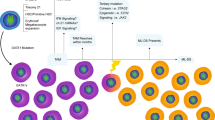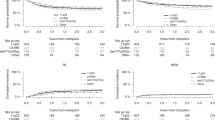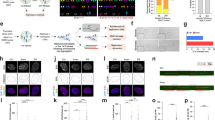Abstract
Down syndrome (DS) is a multifactorial disorder with a high predisposition to leukemia and other malignancies. A change in the replication pattern from synchronous in normal genes to asynchronous in DS amniocytes has previously been reported. The objective of this study was to evaluate additional molecular cytogenetic factors which could re-emphasize the high correlation between DS cells and genetic instability. We found a higher rate of random aneuploidy in chromosomes 9 and 18 and a higher rate of asynchronous replication in the subtelomeric region or DS leukocytes than in cells from normal newborns. In addition, the telomere capture phenomenon was observed in the DS leukocytes but not in normal controls. The molecular cytogenetic factors observed in the DS individuals are known to correlate with genomic instability and with predisposition to cancer.
Similar content being viewed by others
Log in or create a free account to read this content
Gain free access to this article, as well as selected content from this journal and more on nature.com
or
References
Amiel A, Avivi L, Gaber E, Fejgin MD (1998a) Asynchronous replication of allelic loci in Down Syndrome. Eur J Hum Genet 6:359–364
Amiel A, Kolodizner T, Fishman A, Gaber E, Klein Z, Beyth Y, Fejgin MD (1998b) Replication pattern of the p53 and 21q22 loci in the premalignant and malignant stages of carcinoma of the cervix. Cancer 83:1966–1971
Amiel A, Litmanovitch T, Lishner M, Mor A, Gaber E, Tangi I, Fejgin MD, Avivi L (1998c) Temporal differences in replication timing of homologous loci in malignant cells derived from CML and lymphoma patients. Genes Chromosomes Cancer 22:225–231
Amiel A, Korenstein A, Gaber E, Avivi L (1999) Asynchronous replication of alleles in genomes carrying an extra autosome. Eur J Hum Genet 7:223–230
Amiel A, Reish O, Gaber E, Kedar I, Diukman R, Fejgin MD (2000) Replication asynchrony increases in women at risk for aneuploid offspring. Chromosome Res 8:141–150
Amiel A, Goldzak G, Gaber E, Yosef G, Fejgin MD, Yukla M, Lishner M (2005a) Random aneuploidy and telomere capture in chronic lymphocytic leukemia and chronic myeloid leukemia patients. Cancer Genet Cytogenet 163:12–16
Amiel A, Gronich N, Yukla M, Suliman S, Josef G, Gaber E, Drori G, Fejgin MD, Lishner M (2005b) Random aneuploidy in neoplastic and pre-neoplastic diseases, multiple myeloma and monoclonal gammopathy. Cancer Genet Cytogenet 162:78–81
Antonarakis SE, Lyle R, Dermitzakis ET, Reymond A, Deutsch S (2004) Chromosome 21 and Down syndrome: from genomics to pathophysiology. Nat Rev Genet 5:725–738
Ballif BC, Kashork CD, Shaffer LG (2000) FISHing for mechanisms of cytogenetically defined terminal deletions using chromosome-specific subtelomeric probes. Eur J Hum Genet 8:764–770
Birchler JA, Newton KJ (1981) Modulation of protein levels in chromosomal dosage series of maize: the biochemical basis of aneuploid syndromes. Genetics 99:247–266
Birchler JA, Bhadra U, Bhadra MP, Auger DL (2001) Dosage dependent gene regulation in higher eukaryotes: implications for dosage compensation, aneuploid syndromes and quantitative traits. Dev Biol 234:275–288
Birchler JA, Riddle NC, Auger DL, Veitia RA (2005) Dosage balance in gene regulation: biological implications. Trends Genet 21:219–226
Boggs BA, Chinault AC (1994) Analysis of replication timing properties of human X-chromosomal loci by fluorescence in situ hybridization. Proc Natl Acad Sci USA 91:6083–6087
Chess A, Simon I, Cedar H, Axel R (1994) Allele inactivation regulates olfactory receptor gene expression. Cell 78:823–834
Devin RH, et al (1988) The influence of whole-arm trisomy on gene expression in Drosophila. Genetics 118:87–101
Duesberg P, Li R (2003) Multistep carcinogenesis: a chain reaction of aneuploidizations. Cell Cycle 3:202–210
Duesberg P, Rasnick D (2000) Aneuploidy, the somatic mutation that makes cancer a species of its own. Cell Motil Cytoskeleton 47:81–107
Duesberg P, Li R, Rasnick D, Rausch C, Willer A, Kraemer A, Yerganian G, Hehlmann R (2000) Aneuploidy precedes and segregates with chemical carcinogenesis. Cancer Genet Cytogenet 119:83–93
Duesberg P, Fabarius A, Hehlmann R (2004) Aneuploidy, the primary cause of the multilateral genomic instability of neoplastic and preneoplastic cells. IUBMB Life 56:65–81
Fabarius A, Willer A, Yerganian G, Hehlmann R, Duesberg P (2002) Specific aneusomies in Chinese hamster cells at different stages of neoplastic transformation, initiated by nitrosomethylurea. Proc Natl Acad Sci USA 99:6778–6783
FitzPatrick DR (2005) Transcriptional consequences of autosomal trisomy: primary gene dosage with complex downstream effects. Trends Genet 21:249–253
Goldman MA, Holmquist GP, Gray MC, Caston LA, Nag A (1984) Replication timing of mammalian genes and middle repetitive sequences. Science 224:686–692
Guo M, Birchler JA (1994) Trans-acting dosage effects on the expression of model gene systems in maize aneuploids. Science 266:1999–2002
Hatton KS, Dhar VH, Brown EH, Iqbal MA, Stuart S, Didamo VT, Schildkraut CL (1988) Replication program of active and inactive multigene families in mammalian cells. Mol Cell Biol 8:2149–2158
Hernandez D, Fisher EM (1996) Down syndrome genetics: unraveling a multifactorial disorder. Hum Mol Genet 5:1411–1416
Holmquist GP (1987) Role of replication time in the control of tissue specific gene expression. Am J Hum Genet 40:151–173
Hultdin M, Gronlund KF, Norrback T, Just KT, Roos G (2001) Replication timing of human telomeric DNA and other repetitive sequences analyzed by fluorescence in situ hybridization and flow cytometry. Exp Cell Res 271:223–229
Kitsberg D, Selig S, Brandeis M, Simon I, Keshet I, Driscoll DJ, Nicholls RD, Cedar H (1993) Allele-specific replication timing of imprinted gene regions. Nature 364:459–463
McCarroll RM, Fangman WL (1988) Time of replication of yeast centromeres and telomeres. Cell 54:505–513
Meltzer PS, Guan XY, Trent JM (1993) Telomere capture stabilizes chromosome breakage. Nat Genet 4:252–255
Ning Y, Liang JC, Nagarajan J, Schrock E, Ried T (1998) Characterization of 5q deletions by subtelomeric probes and spectral karyotyping. Cancer Genet Cytogenet 103:170–172
Ofir R, Yalon-Hacohen M, Segev Y, Schultz A, Skorecki KL, Selig S (2002) Replication and/or separation of some human telomeres is delayed beyond S-phase in pre-senescent cells. Chromosoma 111:147–155
Rasnick D, Duesberg P (1999) How aneuploidy affects metabolic control and causes cancer. Biochem J 340:621–630
Selig S, Okumuva K, Ward DC, Cedar H (1992) Delineation of DNA replication time zones by fluorescence in situ hybridization. EMBO J 11:1217–1225
Staessen C, Maes AM, Kirsch-Volders M, Susanne C (1983) Is there predisposition for meiotic nondisjunction that may be detected by mitotic hyperploidy? Clin Genet 24:184–190
Stallard R, Haney NR, Frank PA, Styron P, Juberg RC (1981) Leukocyte chromosomes from parents of cytogenetically abnormal offspring: preliminary observations. Cytogenet Cell Genet 30:50–53
Stone JF, Sandberg AA (1995) Sex chromosome aneuploidy and aging. Mutat Res 338:107–113
Author information
Authors and Affiliations
Corresponding author
Rights and permissions
About this article
Cite this article
Amiel, A., Goldzak, G., Gaber, E. et al. Molecular cytogenetic characteristics of Down syndrome newborns. J Hum Genet 51, 541–547 (2006). https://doi.org/10.1007/s10038-006-0395-4
Received:
Accepted:
Published:
Issue date:
DOI: https://doi.org/10.1007/s10038-006-0395-4



